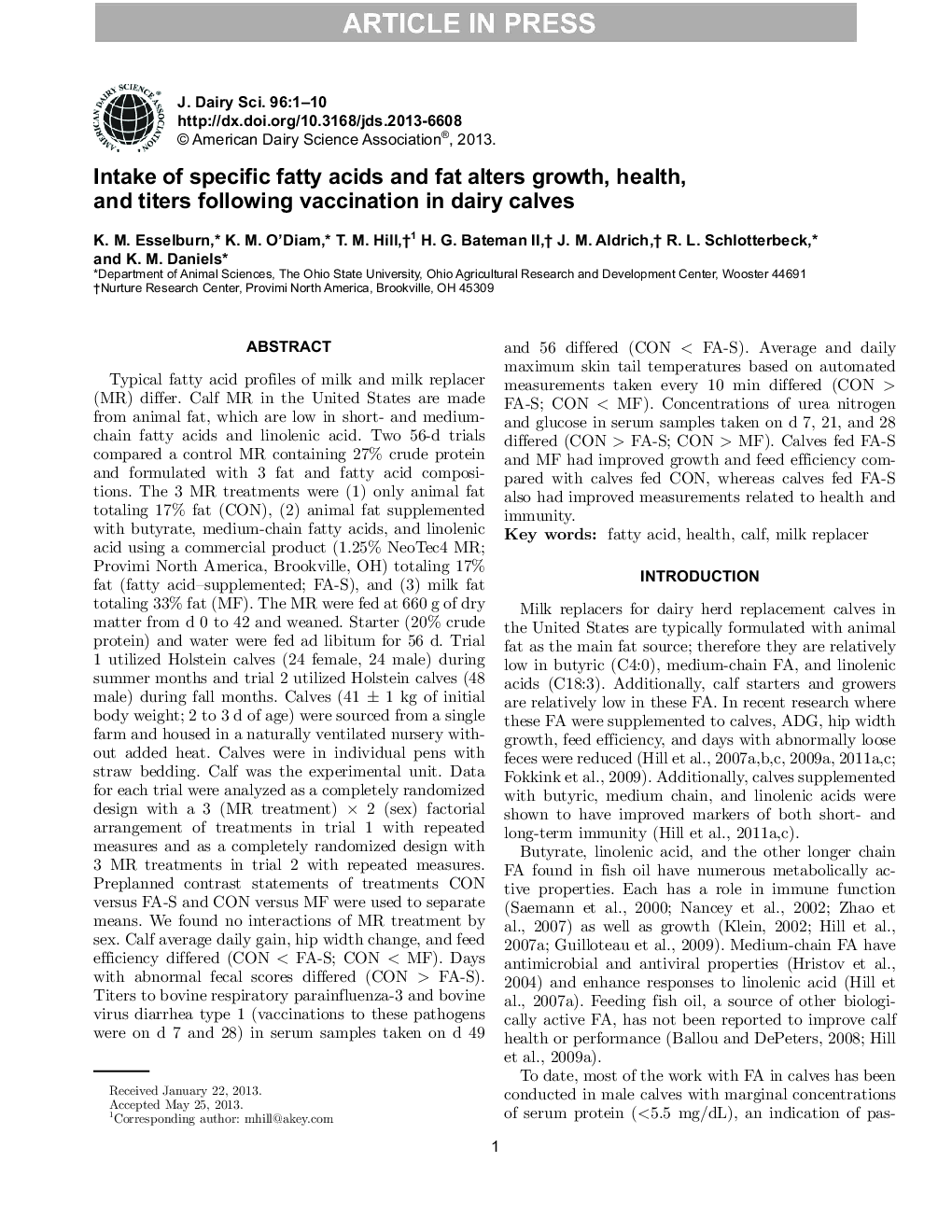| کد مقاله | کد نشریه | سال انتشار | مقاله انگلیسی | نسخه تمام متن |
|---|---|---|---|---|
| 10977596 | 1108050 | 2013 | 10 صفحه PDF | دانلود رایگان |
عنوان انگلیسی مقاله ISI
Intake of specific fatty acids and fat alters growth, health, and titers following vaccination in dairy calves
ترجمه فارسی عنوان
مصرف چربی های اسیدهای چرب و چربی باعث تغییر رشد، سلامتی و تیترهای بعد از واکسیناسیون در گوساله های شیری می شود
دانلود مقاله + سفارش ترجمه
دانلود مقاله ISI انگلیسی
رایگان برای ایرانیان
کلمات کلیدی
اسید چرب، سلامتی، گوساله، جایگزین شیر،
موضوعات مرتبط
علوم زیستی و بیوفناوری
علوم کشاورزی و بیولوژیک
علوم دامی و جانورشناسی
چکیده انگلیسی
Typical fatty acid profiles of milk and milk replacer (MR) differ. Calf MR in the United States are made from animal fat, which are low in short- and medium-chain fatty acids and linolenic acid. Two 56-d trials compared a control MR containing 27% crude protein and formulated with 3 fat and fatty acid compositions. The 3 MR treatments were (1) only animal fat totaling 17% fat (CON), (2) animal fat supplemented with butyrate, medium-chain fatty acids, and linolenic acid using a commercial product (1.25% NeoTec4 MR; Provimi North America, Brookville, OH) totaling 17% fat (fatty acid-supplemented; FA-S), and (3) milk fat totaling 33% fat (MF). The MR were fed at 660 g of dry matter from d 0 to 42 and weaned. Starter (20% crude protein) and water were fed ad libitum for 56 d. Trial 1 utilized Holstein calves (24 female, 24 male) during summer months and trial 2 utilized Holstein calves (48 male) during fall months. Calves (41 ± 1 kg of initial body weight; 2 to 3 d of age) were sourced from a single farm and housed in a naturally ventilated nursery without added heat. Calves were in individual pens with straw bedding. Calf was the experimental unit. Data for each trial were analyzed as a completely randomized design with a 3 (MR treatment) à 2 (sex) factorial arrangement of treatments in trial 1 with repeated measures and as a completely randomized design with 3 MR treatments in trial 2 with repeated measures. Preplanned contrast statements of treatments CON versus FA-S and CON versus MF were used to separate means. We found no interactions of MR treatment by sex. Calf average daily gain, hip width change, and feed efficiency differed (CON < FA-S; CON < MF). Days with abnormal fecal scores differed (CON > FA-S). Titers to bovine respiratory parainfluenza-3 and bovine virus diarrhea type 1 (vaccinations to these pathogens were on d 7 and 28) in serum samples taken on d 49 and 56 differed (CON < FA-S). Average and daily maximum skin tail temperatures based on automated measurements taken every 10 min differed (CON > FA-S; CON < MF). Concentrations of urea nitrogen and glucose in serum samples taken on d 7, 21, and 28 differed (CON > FA-S; CON > MF). Calves fed FA-S and MF had improved growth and feed efficiency compared with calves fed CON, whereas calves fed FA-S also had improved measurements related to health and immunity.
ناشر
Database: Elsevier - ScienceDirect (ساینس دایرکت)
Journal: Journal of Dairy Science - Volume 96, Issue 9, September 2013, Pages 5826-5835
Journal: Journal of Dairy Science - Volume 96, Issue 9, September 2013, Pages 5826-5835
نویسندگان
K.M. Esselburn, K.M. O'Diam, T.M. Hill, H.G. II, J.M. Aldrich, R.L. Schlotterbeck, K.M. Daniels,
